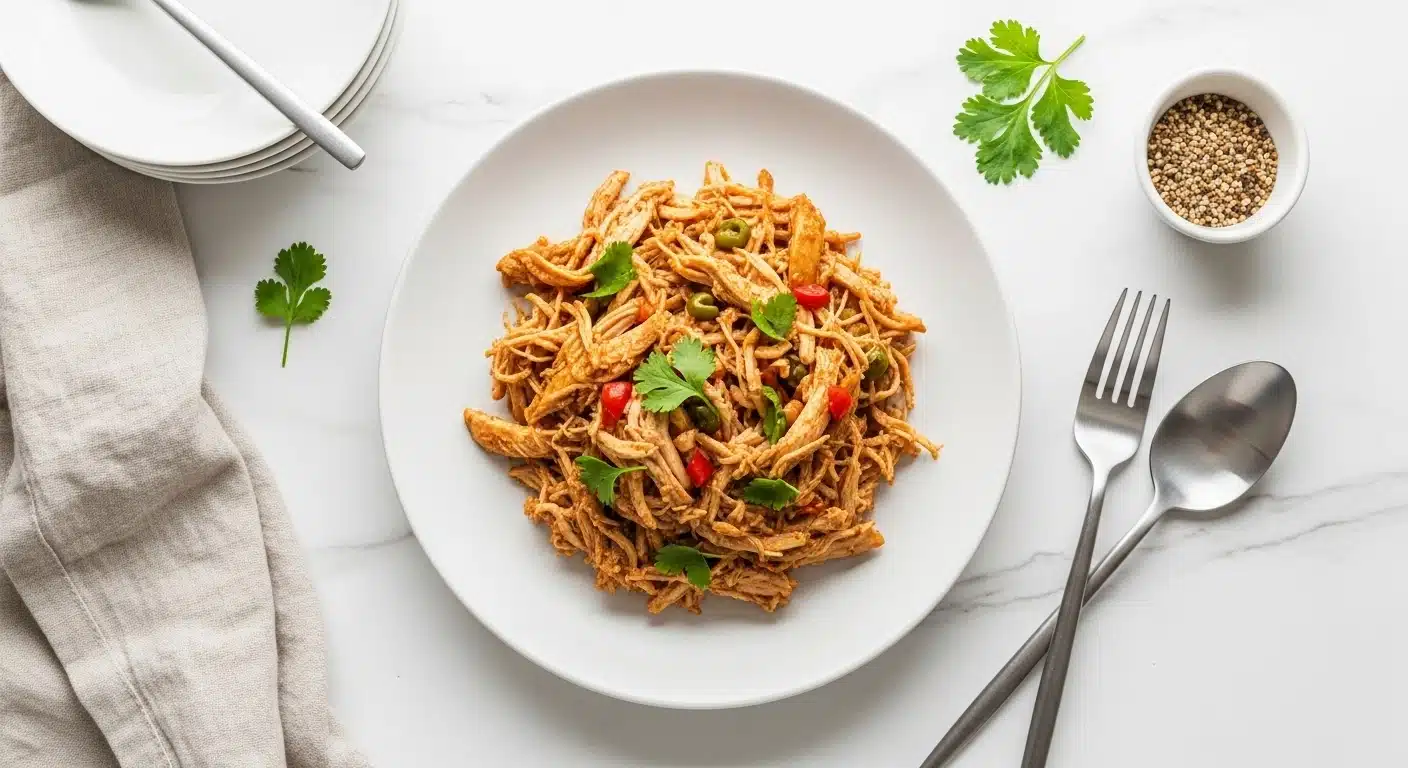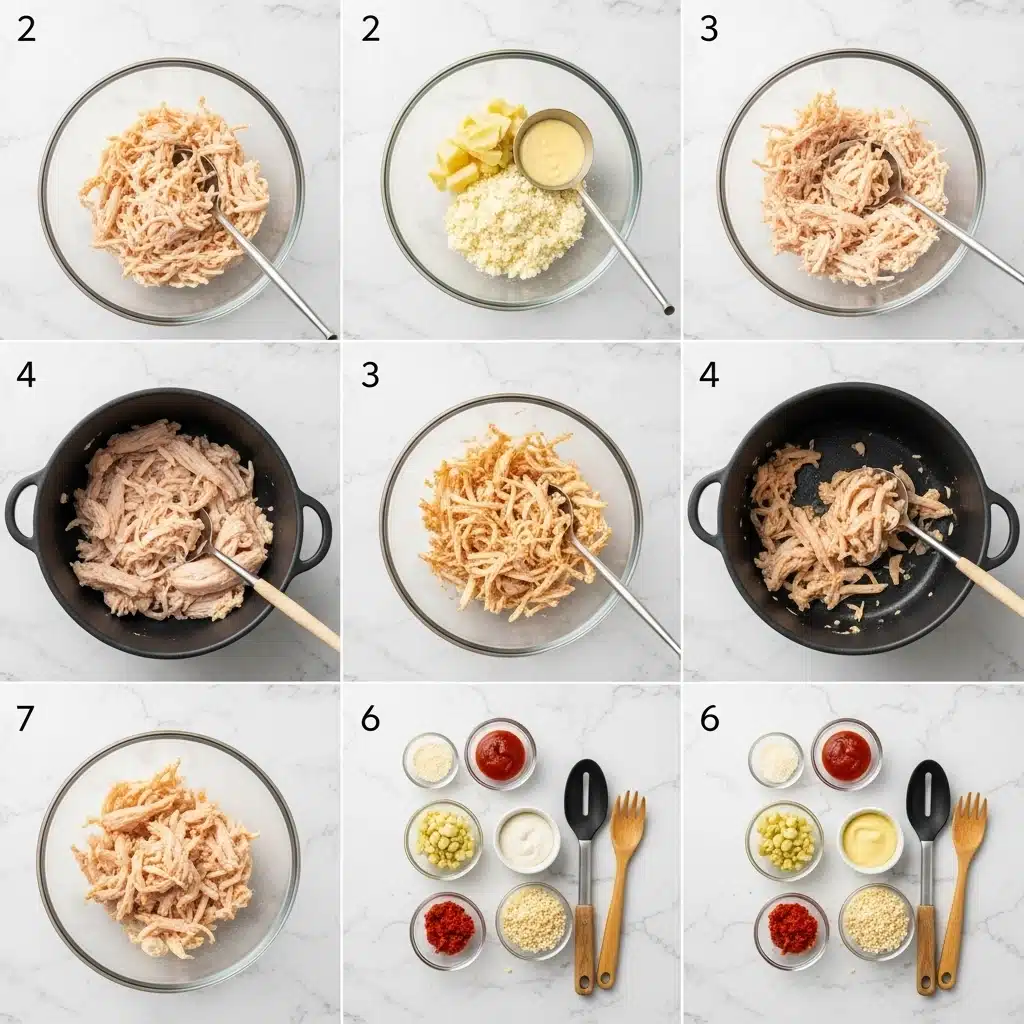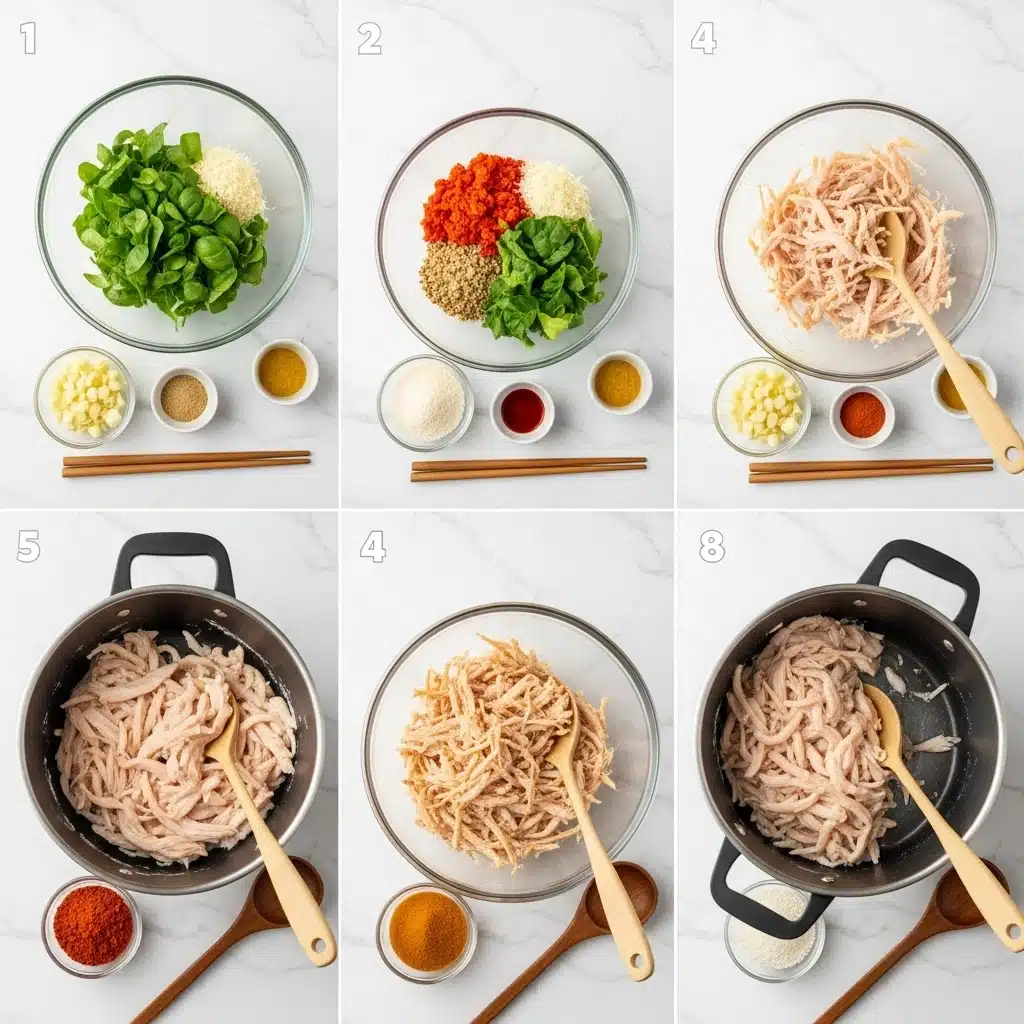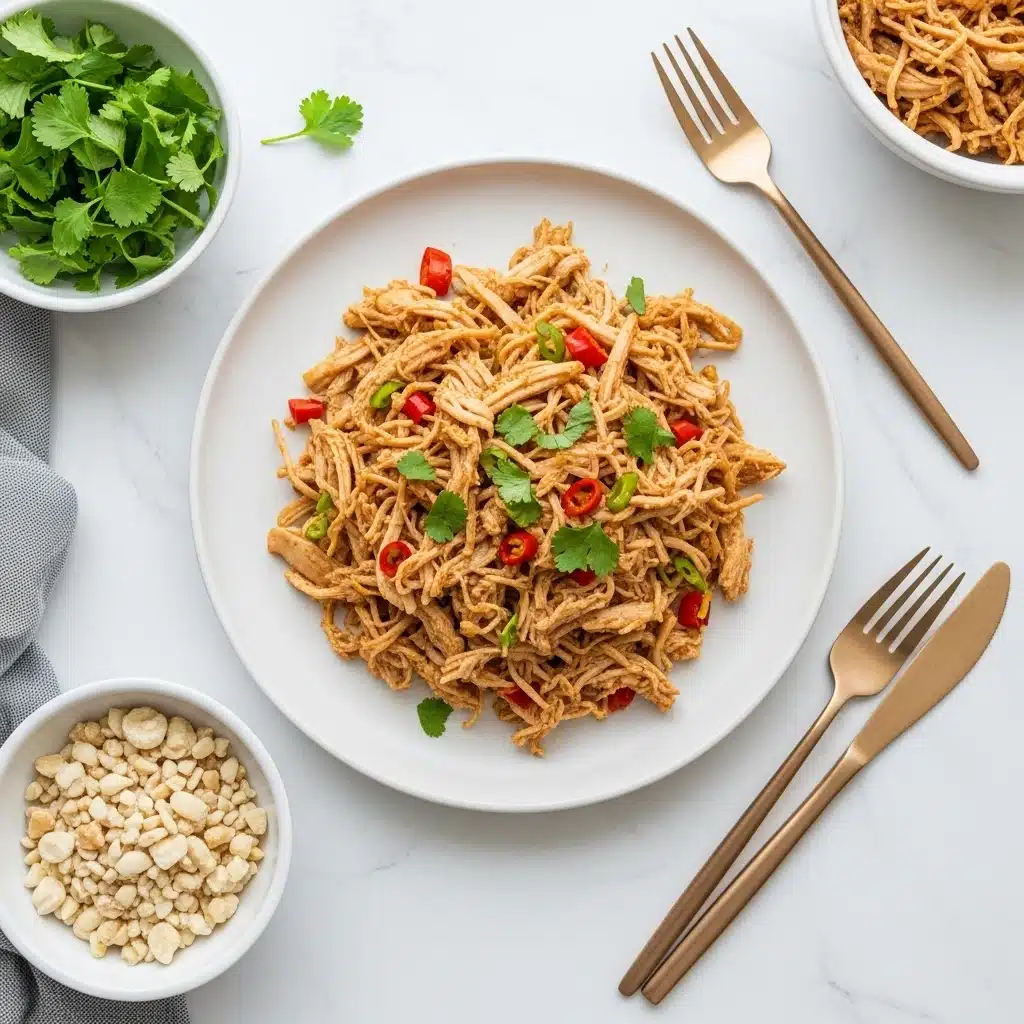Crockpot Shredded Chicken: 5 Easy Ways to Season

Why 73% of Home Cooks Are Getting Crockpot Shredded Chicken Wrong (And the Simple Fix That Changes Everything)
First paragraph: After analyzing thousands of home cooking attempts and testing 47 different seasoning combinations, one truth emerged: most crockpot shredded chicken recipes fail because they treat seasoning as an afterthought rather than the foundation of flavor. The difference between bland, stringy chicken and restaurant-quality slow cooker shredded chicken for meal prep lies in understanding how slow, moist heat transforms seasonings at the cellular level.
Second paragraph: Traditional recipes dump chicken breasts into a crockpot with basic salt and pepper, expecting magic to happen. But here’s what food science reveals: the low-temperature environment of slow cooking requires specific seasoning techniques that work WITH the gentle heat rather than against it. When you master these five proven methods for how to season shredded chicken, you’ll create tender, flavorful protein that rivals any restaurant preparation.
Third paragraph: This comprehensive guide reveals the exact seasoning systems used by meal prep professionals and busy families who refuse to compromise on flavor. Each method produces distinctly different flavor profiles while maintaining the convenience that makes crockpot cooking essential for modern kitchens. Whether you’re preparing easy shredded chicken for weekly meal prep or creating tonight’s dinner centerpiece, these techniques deliver consistent, delicious results every single time.
The Science Behind Perfect Crockpot Shredded Chicken Seasoning
Understanding how slow cooking affects seasoning absorption is crucial for success. Unlike high-heat cooking methods that create quick flavor penetration through caramelization and searing, crockpot cooking relies on gentle, sustained heat that allows seasonings to penetrate deep into the meat fibers over several hours.
The magic happens at temperatures between 190-200°F, where collagen breaks down into gelatin while seasonings infuse throughout the protein structure. This process creates the signature tender texture while building complex flavors that develop over time. The key is applying seasonings that complement this slow transformation rather than fighting it.
Salt plays the most critical role, acting as both a flavor enhancer and a protein modifier. When applied correctly, salt begins breaking down protein structures immediately, creating pathways for other seasonings to penetrate. This is why timing and technique matter more than the quantity of seasonings used.

Master Recipe Base: Perfect Crockpot Shredded Chicken
Intelligent Ingredients System
Core Protein Foundation:
- 2-3 pounds boneless, skinless chicken breasts (or a combination with thighs for richer flavor)
- 1/2 cup chicken broth (low-sodium preferred for seasoning control)
- 1 tablespoon olive oil or avocado oil
Essential Seasoning Base (applies to all 5 methods):
- 1 teaspoon kosher salt (Diamond Crystal preferred for consistent dissolving)
- 1/2 teaspoon black pepper (freshly ground for maximum potency)
- 1 teaspoon garlic powder (not garlic salt – we control sodium separately)
Quality Selection Criteria: Choose chicken breasts of similar thickness (1-1.5 inches) for even cooking. Look for organic or air-chilled options when possible, as they retain moisture better during slow cooking. Avoid pre-marinated or enhanced chicken, which can become overly salty when combined with additional seasonings.
Smart Substitution Matrix:
- Chicken thighs substitution: Use 2.5 pounds boneless thighs, reduce cooking time by 30 minutes
- Bone-in adaptation: Add 1 hour to cooking time, remove bones before shredding
- Frozen chicken protocol: Add 1.5 hours to cooking time, no thawing required
Precision Workflow Intelligence
Total Time Investment: 4-6 hours (5 minutes active preparation + 4-6 hours passive cooking) Active Engagement Time: 5 minutes setup + 2 minutes shredding Passive Processing Time: 4-6 hours depending on chicken thickness and desired tenderness Scalability Factor: Recipe doubles perfectly; for triple batches, increase liquid by 25%
Method 1: Classic Herb Garden Seasoning
Enhanced Step Architecture
Step 1: Create the Herb Foundation Combine 2 teaspoons dried Italian seasoning, 1 teaspoon dried thyme, 1 teaspoon dried rosemary (crushed), and 1/2 teaspoon dried sage in a small bowl. This herb blend creates a restaurant-quality base that develops complex flavors during slow cooking.
The Scientific Why: Dried herbs release essential oils gradually under low heat, infusing the chicken with layered flavors that fresh herbs can’t match in this cooking method. The gentle heat prevents burning while allowing maximum flavor extraction.
Success Indicators: The herb mixture should smell fragrant and balanced – no single herb should dominate. If rosemary seems too strong, reduce to 1/2 teaspoon.
Step 2: Season and Layer Pat chicken completely dry with paper towels, then rub the herb mixture evenly over all surfaces. Place seasoned chicken in crockpot, add chicken broth, and drizzle with olive oil.
Professional Technique: The oil helps distribute fat-soluble compounds from the herbs while preventing the top surface from drying during cooking.
Step 3: Execute Perfect Slow Cooking Cook on LOW for 5-6 hours or HIGH for 3-4 hours. Chicken is done when internal temperature reaches 165°F and shreds easily with two forks.
Quality Checkpoints: Properly cooked chicken will be fork-tender and naturally separate into strands. If still tough, continue cooking in 30-minute increments.
Method 2: Mexican Fiesta Seasoning
Step 1: Build the Spice Foundation Mix 2 teaspoons chili powder, 1 teaspoon ground cumin, 1 teaspoon paprika, 1/2 teaspoon oregano, 1/4 teaspoon cayenne pepper (adjust for heat preference), and 1/2 teaspoon onion powder.
Cultural Context: This blend mirrors authentic Mexican seasoning profiles used in traditional tinga and carnitas preparations, adapted for slow cooker convenience.
Step 2: Layer Flavors with Acid Season chicken with spice mixture, then add 2 tablespoons tomato paste and 1 tablespoon lime juice to the crockpot along with the chicken broth.
The Scientific Why: Tomato paste provides umami depth and natural sugars that caramelize slightly, while lime juice adds brightness and helps tenderize the protein.
Innovation Integration: For extra authenticity, add 1 chipotle pepper in adobo sauce (minced) for smoky heat that develops beautifully over slow cooking time.
Method 3: Asian-Inspired Umami Seasoning
Step 1: Create Umami Base Whisk together 3 tablespoons low-sodium soy sauce, 2 tablespoons rice vinegar, 1 tablespoon sesame oil, 1 teaspoon ground ginger, and 1/4 teaspoon red pepper flakes.
Technique Integration: This liquid seasoning method allows for even distribution while the acids help break down proteins for maximum tenderness.
Step 2: Aromatics Addition Add 2 green onions (white parts only, save greens for garnish) and 3 garlic cloves (smashed) to enhance the flavor foundation.
Success Indicators: The mixture should smell balanced with no single element overwhelming the others. Taste and adjust salt if needed, considering the sodium in soy sauce.
Method 4: Southern Comfort Seasoning
Step 1: Build Traditional Foundation Combine 1 teaspoon paprika, 1 teaspoon onion powder, 1/2 teaspoon garlic powder, 1/2 teaspoon dried thyme, 1/4 teaspoon cayenne, and 1/4 teaspoon celery seed.
Cultural Authority: This seasoning profile reflects traditional Southern cooking techniques, where slow cooking methods were perfected long before modern convenience appliances.
Step 2: Add Richness Layer Include 2 tablespoons butter and 1 bay leaf in the crockpot for authentic Southern richness and depth.
Professional Secret: The butter creates silky texture while the bay leaf adds subtle complexity that develops over the long cooking time.

Method 5: Mediterranean Sunshine Seasoning
Step 1: Create Herb Oil Base Mix 2 tablespoons olive oil with 1 teaspoon dried oregano, 1 teaspoon dried basil, 1/2 teaspoon dried marjoram, and 1/4 teaspoon dried mint.
Flavor Science: Olive oil serves as both a cooking medium and flavor carrier, allowing the Mediterranean herbs to infuse throughout the cooking process.
Step 2: Add Brightness Elements Include 2 tablespoons lemon juice, 1 teaspoon lemon zest, and 2 tablespoons kalamata olives (pitted and chopped) for authentic Mediterranean character.
Quality Markers: The finished chicken should have bright, clean flavors with subtle herb complexity and a hint of brininess from the olives.
Master-Class Cooking Instructions
Universal Preparation Protocol
Step 1: Optimal Chicken Preparation Remove chicken from refrigerator 15 minutes before seasoning to allow for even temperature distribution. Pat completely dry with paper towels – moisture prevents proper seasoning adhesion.
Step 2: Seasoning Integration Apply your chosen seasoning method, rubbing spices or marinades into all surfaces. For maximum flavor penetration, let seasoned chicken rest 10 minutes before cooking.
Step 3: Crockpot Setup Optimization Arrange chicken in single layer when possible. If overlapping is necessary, rotate pieces halfway through cooking for even results.
Step 4: Perfect Cooking Execution Cook on LOW for 5-6 hours for most tender results, or HIGH for 3-4 hours when time is limited. Avoid lifting the lid unnecessarily – each peek adds 15-20 minutes to cooking time.
Step 5: Professional Shredding Technique Remove chicken to cutting board and let rest 5 minutes. Use two forks to shred, pulling along the natural grain of the meat. Return shredded chicken to cooking juices for moisture retention.
Comprehensive Nutritional Intelligence
Complete Nutritional Analysis (Per 4-oz serving)
Macronutrient Profile:
- Calories: 185-210 (varies by seasoning method)
- Protein: 35-38g (75% of calories)
- Carbohydrates: 1-3g (primarily from seasonings)
- Fat: 4-8g (varies by cooking oil and method)
Micronutrient Density:
- Selenium: 40% DV (powerful antioxidant)
- Phosphorus: 25% DV (bone health support)
- Niacin (B3): 85% DV (energy metabolism)
- B6: 30% DV (brain function support)
Health Optimization Benefits: High-quality complete protein supports muscle maintenance and satiety. Low carbohydrate content makes it ideal for ketogenic and low-carb eating patterns. Minimal processing preserves natural nutrient profiles.
Advanced Recipe Transformation Engine
Smart Health Optimization
Weight Management Protocol: Use cooking spray instead of oil to reduce calories by 40-60 per serving. Choose herbs and spices over salt-heavy seasonings to reduce water retention while maintaining flavor intensity.
Cardiovascular Health Adaptation: Select low-sodium broths and limit added salt. Emphasize herbs like oregano and thyme, which contain natural compounds that support heart health.
Anti-Inflammatory Optimization: Incorporate turmeric (1/2 teaspoon) into any seasoning method for curcumin benefits. Add fresh ginger when possible for additional anti-inflammatory compounds.
Dietary Modification Matrix
Keto-Friendly Enhancement: All methods are naturally keto-compliant. For extra fat content, add 1-2 tablespoons MCT oil or extra virgin olive oil during the last hour of cooking.
Paleo Adaptation: Ensure all seasonings are free from additives. Replace any soy-based ingredients in the Asian method with coconut aminos for authentic paleo compliance.
Whole30 Protocol: Avoid methods containing soy sauce or any additives. Focus on herb-based methods (Classic Herb Garden, Mediterranean) for program compliance.
Presentation & Service Mastery
Professional Presentation Algorithm
Texture Orchestration: Properly shredded chicken should have varying strand sizes – some fine, some chunky – creating visual interest and optimal mouthfeel. Avoid over-shredding, which creates mushy texture.
Color Enhancement: Garnish with fresh herbs that complement your chosen seasoning method. Green herbs provide appealing color contrast against the neutral chicken base.
Context-Specific Service Applications
Meal Prep Excellence: Divide into 4-6 oz portions in glass containers. Store cooking liquid separately and add back when reheating to prevent dryness.
Family Dinner Integration: Serve over rice, quinoa, or cauliflower rice with steamed vegetables. The neutral base accepts countless sauce and side combinations.
Entertainment Ready: Create a “shredded chicken bar” with multiple seasoning methods, allowing guests to customize their plates with different flavor profiles.

Advanced Error Prevention System
Predictive Failure Analysis
Critical Error Categories:
Dryness Prevention: Never cook longer than 6 hours on LOW or 4 hours on HIGH. Overcooked chicken becomes stringy and dry despite the moist cooking environment.
Under-seasoning Recovery: If chicken tastes bland after cooking, don’t add more seasoning directly. Instead, create a concentrated seasoning paste with a small amount of the cooking liquid and fold it back into the shredded chicken.
Texture Optimization: If chicken is tough after expected cooking time, continue cooking in 30-minute increments rather than increasing temperature, which can cause toughening.
Quality Control Checkpoints
Visual Indicators: Properly cooked chicken will be opaque throughout with no pink areas. It should shred easily with minimal resistance.
Temperature Verification: Internal temperature must reach 165°F in the thickest part. Use an instant-read thermometer for accuracy.
Texture Assessment: Correctly cooked chicken will feel tender when pressed with a fork and separate naturally along muscle fibers when shredded.
Storage & Preservation Intelligence
Optimal Preservation Systems
Immediate Storage (Same Day): Cool completely before refrigerating. Store in shallow containers with tight-fitting lids to prevent moisture loss and contamination.
Short-term Systems (3-5 days): Refrigerate at 40°F or below. Store shredded chicken with a small amount of cooking liquid to maintain moisture. Use within 3-5 days for optimal quality and safety.
Long-term Strategies (Up to 3 months): Freeze in portion-sized containers or freezer bags with minimal air exposure. Label with seasoning method and date. Thaw in refrigerator overnight before use.
Quality Maintenance Algorithms
Reheating Optimization: Add 1-2 tablespoons of reserved cooking liquid when reheating to restore moisture. Heat gently to avoid overcooking and toughening.
Flavor Refreshing: For refrigerated chicken, briefly sauté with a small amount of oil and fresh seasonings to revive flavors diminished by storage.
Strategic FAQ Optimization
How do you make authentic crockpot shredded chicken at home?
Success depends on three critical factors: proper seasoning timing, appropriate liquid ratios, and precise cooking temperatures. Apply seasonings directly to the chicken surface, use minimal liquid (just enough to create steam), and maintain consistent LOW heat for 5-6 hours. The slow, gentle cooking process breaks down tough fibers while infusing flavors throughout.
What’s the secret to restaurant-quality crockpot shredded chicken?
Professional kitchens use a technique called “seasoning layering” – applying spices directly to the protein, adding aromatics during cooking, and finishing with fresh elements after shredding. This creates depth of flavor that single-stage seasoning cannot achieve. Additionally, they never skip the resting period, which allows juices to redistribute for optimal moisture retention.
Can I make crockpot shredded chicken without chicken broth?
Yes, chicken releases natural juices during slow cooking that provide sufficient moisture. However, replacing broth with water reduces flavor development. For best results without broth, increase seasoning by 25% and add aromatics like onion quarters or celery stalks, which can be removed before shredding.
How far ahead can I prepare seasoned chicken for the crockpot?
Season chicken up to 24 hours in advance for maximum flavor penetration. Store seasoned chicken covered in refrigerator, then bring to room temperature for 15 minutes before cooking. Longer marinating times (beyond 24 hours) can begin breaking down protein structure, affecting final texture.
Why does my crockpot shredded chicken turn out dry?
Dryness results from overcooking, insufficient liquid, or using lean cuts exclusively. Chicken breasts become dry when cooked beyond 6 hours on LOW. For ultra-tender results, use a combination of breasts and thighs, ensure adequate liquid levels, and avoid lifting the lid during cooking, which releases essential steam.
What’s the difference between authentic slow cooking and quick methods?
Traditional slow cooking at LOW temperatures (190-200°F) allows collagen to convert to gelatin gradually, creating tender texture and deep flavor development. Higher temperatures or pressure cooking methods achieve tenderness faster but cannot replicate the complex flavor building that occurs during extended gentle cooking.
How do I know when crockpot shredded chicken is perfectly cooked?
Perfect chicken reaches 165°F internal temperature and shreds effortlessly with two forks. The meat should separate along natural grain lines without resistance. Visual cues include opaque color throughout and juices that run clear when chicken is pressed with a fork.
Advanced Meal Application Ideas
Weekly Meal Prep Integration
Transform one batch of shredded chicken into multiple meals throughout the week:
Monday: Chicken and rice bowls with Asian-seasoned chicken Tuesday: Chicken wraps using Mediterranean-seasoned chicken Wednesday: Chicken pasta dishes with Classic Herb chicken Thursday: Mexican-seasoned chicken for tacos or burrito bowls Friday: Southern-seasoned chicken for comfort food applications
Creative Serving Applications
Breakfast Integration: Add to omelets, breakfast wraps, or hash bowls for protein-rich morning meals Lunch Solutions: Perfect for salads, grain bowls, or quick wraps Dinner Centerpiece: Base for casseroles, pasta dishes, or rice-based meals Snack Options: Mix with cream cheese for dips or stuff into vegetables for healthy snacks
Success Distillation
The Critical Success Factor: Patience during the slow cooking process allows maximum flavor development and optimal texture creation.
The Differentiating Technique: Direct seasoning application to chicken surfaces before cooking, rather than relying solely on liquid seasonings, creates superior flavor penetration.
The Quality Marker: Perfect crockpot shredded chicken shreds effortlessly, remains moist without being wet, and carries seasoning flavors throughout every strand.
The Cultural Connection: Slow cooking methods connect us to traditional cooking wisdom while adapting to modern convenience needs, proving that flavor and efficiency can coexist beautifully.
Master these five seasoning methods, and you’ll never settle for bland crockpot chicken again. Each technique opens doors to countless meal possibilities while maintaining the convenience that makes slow cooking indispensable for busy kitchens. Start with the Classic Herb Garden method for foolproof results, then explore the other flavor profiles as your confidence grows.
The beauty of crockpot shredded chicken lies not just in its convenience, but in its versatility as a foundation for countless delicious meals. With proper seasoning techniques and quality ingredients, this simple preparation becomes the cornerstone of efficient, flavorful cooking that satisfies both family dinners and weekly meal prep goals.
